“I Have Not Slept for 45 Days”: A Day in a Military Psychological Rehabilitation Unit
Sasha is tall, strong and has large palms. He worked as a marketing specialist until 24 February 2022. When the full-scale invasion began, he sent his wife and child abroad and joined the army.
For 10 months now, Sasha has been undergoing psychological rehabilitation in various centres. He is currently the longest-serving patient in the military wing of the psychiatric hospital.
Sasha is just one of thousands of soldiers who have seen hell and cannot forget it — but are learning to live with it.
Silence and sleep
The floor of the psychiatric hospital where the soldiers are housed consists of two small corridors with exits to the wards and doctors’ offices. In the reception area, there are flags with the insignia of different brigades and messages of thanks from soldiers who have been treated.
Opposite one of the wards is a small zoo: there are two cats, an iguana, a python, several lizards and lots of noisy parrots. There is a sofa and a bookshelf in the common room. Doctors and nurses bring medicines to the table in the corridor and distribute the patients’ pills for the morning. The military patients take their doses and return to their rooms.
Most of the patients in the unit have blunt force injuries from mine explosions. Some have been diagnosed with anxiety-depressive disorder. This is a condition in which people lack the motivation to do anything, sleep poorly, eat little, and feel tired for long periods of time. It is sometimes accompanied by symptoms of post-traumatic stress disorder.
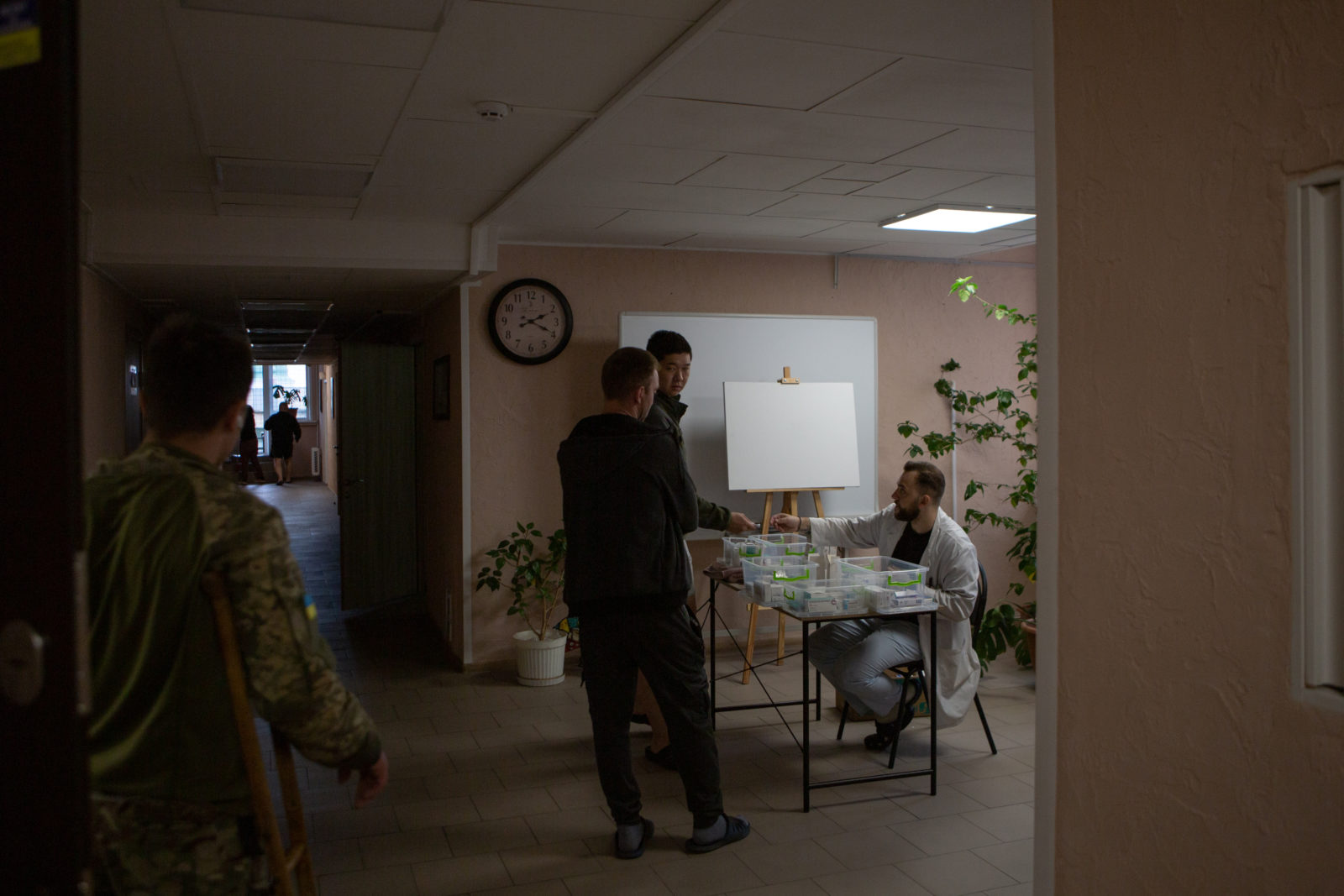
Doctors and nurses put pills with the right dosage into containers. Photo: Oleksandr Mahula/Suspilne
“When your mother-in-law finds you at the window and you tell her, ‘Don’t turn on the light, the assholes are coming in,’ it’s a bad sign,” says Sasha. “I didn’t remember any of this had happened, and she repeated it once, twice, three times. So I went to my GP, who referred me to a psychiatrist. But the psychiatrist was unable to help me and told me to go to a military hospital. Then a buddy told me about this place, and now I’m here.”
For the first 10 days, Sasha was able to sleep. Only for three hours at a time, with medication, but he slept. Gradually he became less irritable. Then the doctor adjusted the dosage of his medication and he started working with a psychotherapist.
“Because there’s no point in sleeping. You have constant flashbacks, both at night and during the day,” Sasha continues, “In my first battle, we killed a lot of people. You could see their bodies from the window. Sometime after that night, I looked down the gun scope and saw a cat eating dead bastards. Once, when I was back home, I woke up in the middle of the night to find my cat, Vaska, tapping on the window, which immediately reminded me of that scene. I looked at the cat and couldn’t sleep anymore. It’s not that you’re tired. It’s just that the sleep is gone. Pills aren’t enough. Everything takes time.”
Soldiers here have plenty of time. There are mandatory procedures, physiotherapy, medication and consultations with doctors — but they spend their free time as they please. Sasha reads and listens to books. He is currently reading Essentialism by Greg McKeown, and before that he read The black swan by Nassim Taleb — a book relevant to his civilian job. Sometimes volunteers come to the military rehabilitation unit; they give art classes, and once they organised a trip to the cinema to see the Ukrainian film My thoughts are silent.
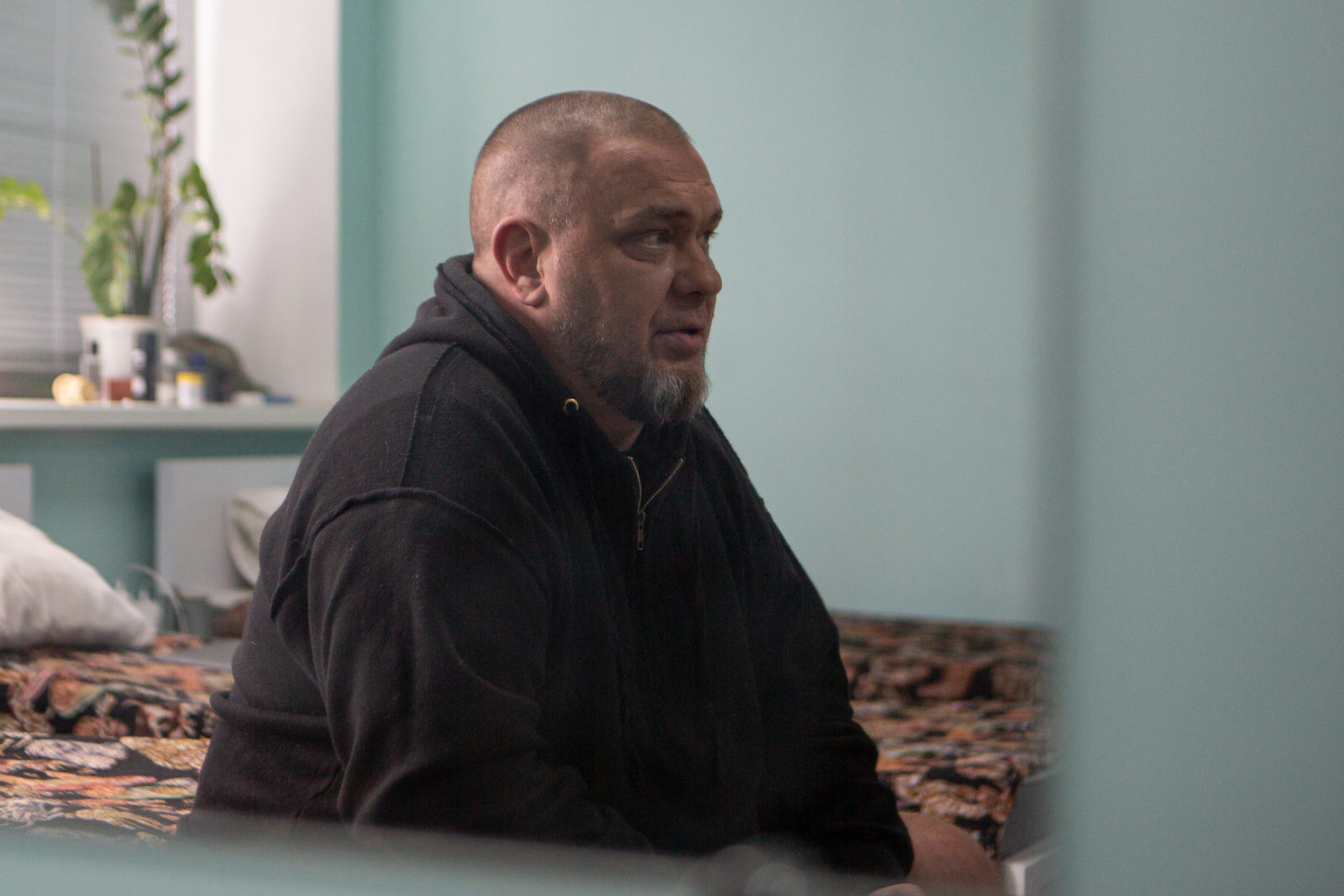
Sasha has been undergoing psychological rehabilitation in various centres for ten months. He has been in the military ward of the psychiatric hospital the longest of all patients. Photo: Oleksandr Mahula/Suspilne
But Sasha, like many other soldiers, starts his mornings by going to the gym. The patients go to the gym not only to keep fit, but also to tire themselves out so they can sleep better.
Viktor takes us to the gym. He is 53 years old and has won several powerlifting championships. He was a teacher before the invasion, but a month before the war he set European records at the Eurasian Championships. Viktor wears a braided bracelet on his wrist — a gift from his students — the kind girls make for soldiers going off to war.
“On my first day, I went to the military enlistment office, where I got a draft notice and headed to Chernihiv. Then I spent ten months in combat — seven months in Vuhledar and three in Bakhmut. We were a separate unit operating man-portable air-defence systems. My comrade and I shot down six helicopters and one Su-25,” Viktor recounts. “The first time I got a concussion, I was not sent home — but the second time… we were in the east. The temperature was -20 degrees and we had only two trench candles for two weeks. A helicopter approached, we too aim, fired and the missile launched. But at that moment the helicopter aligned with the assholes’ bunker. And the missiles react to heat. Because the weather was so cold, the fuckers heated up their bunker so much that there was more heat coming from their bunker than from the helicopter. So the missile hit the bunker, exploded there, and the KA-52 helicopter opened fire on us. What happened next is a blur. I just remember being taken back to our base and then to the hospital.”
After his second concussion, Viktor suffered a heart attack and blood pressure problems, which caused him to lose consciousness. He was nauseous, had headaches and his eyesight was impaired. As a result, he was transferred from the central hospital to the psychiatric ward. The injury caused him to stutter, but after six months of treatment his stuttering was almost unnoticeable.
“I remember when I first came here, I slept for a week. I slept, ate, went to the toilet, and slept again,” says Viktor. “Everyone here is in serious condition when they arrive. It’s all the same.”
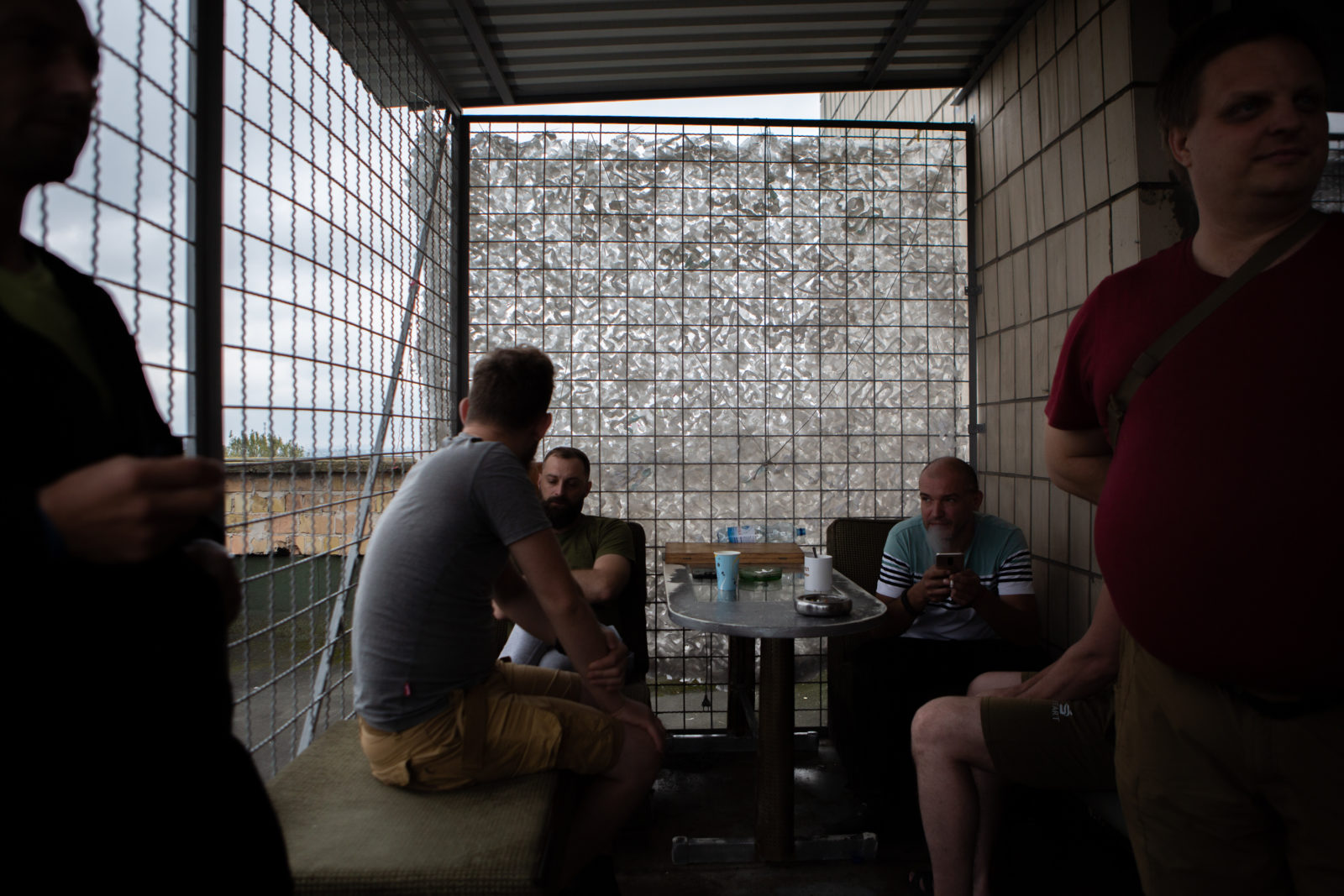
Part of the exit from the compartment to the roof is fenced off with a net. Previously, under Soviet approaches to psychiatry, patients were kept in such cages with locked doors. Now it’s just a smoking room. Photo: Oleksandr Mahula/Suspilne
Viktor’s rehabilitation is almost over. The results of the Military Medical Commission (MMC) are expected soon. He is about to go home for the weekend — his son is waiting for him in the car outside.
“I remember once we were on combat alert. It was the end of my shift, so I had a chance to sleep. I didn’t have a phone connection, but before I dozed off I looked at videos and photos of my granddaughter, and that’s how I fell asleep. My fellow soldier, who was sleeping above me and with whom I’d shot down helicopters, said he heard a strange sound: ’oo-choo-roo-choo-choo, oo-choo-roo-choo-choo’. It was me dreaming of my granddaughter after watching her videos. In the middle of the war and the bombing, in my dream I was walking with my granddaughter,” Viktor laughs, showing her photo on his phone.
“We do what we can. Whatever has to happen will happen”
Viktor and I walk back to the ward. At the end of the corridor is an exit to the roof. Part of it is fenced in with a net. Once on the roof, people find themselves in a small cage with a locked door. This is the only place in the ward that reminds us of Soviet approaches to psychiatry — patients used to be kept in cages like this. The methods have changed, but the cage remains. Now it is a smoking room with a table and chairs.
Sasha smokes near the door.
“Would you like me to introduce you to the nurse who first met me in this ward?” he asks. “I was admitted around half past midnight. I couldn’t sleep because they hadn’t given me any medication yet. They showed me where the smoking area was. So I was sitting there, smoking, when Viktor Mykolaiovych came up to me. I remember telling him that I had forgotten my cup (for the ashes). He went somewhere, came back, gave me the cup, and said I now had my own. Viktor Mykolaiovych, wait up!” Sasha walks into the corridor and waves to a man with glasses and a green uniform.
Viktor Mykolaiovych doesn’t remember the story of the cup. He has been working as a psychiatric nurse for about four years. Before that he was a carpenter, he retired and got a job at the hospital. He works a 24-hour shift and then has four days off.
“It’s just my job,” he explains. “People often come to us wound up, stressed, with injuries and psychological problems. They’re soldiers, they’ve been through a lot, and sometimes you just need to talk to them, have a conversation. Today, for example, I helped take a patient to the dentist. He has an injured knee and needs a joint replacement. I asked the dentist to take this into account and to be gentle with the patient. Or when a soldier is brought in with nothing after leaving the hospital, not even slippers. Then we have to find a pair for him. It’s nothing special, it’s just the nature of the job.”
“So, it’s just a humane approach?”
“Yes. The war is terrible, and our boss told us that our attitude to soldiers should be completely different from that to other patients.”
***
The boss is Igor Dubinin, head of the psychiatric department. He doesn’t have much time for long conversations, so he sets aside five minutes for the interview, but we end up taking twenty. Dubinin explains that during the first week, the doctors try to restore the soldiers’ sleep and reduce their emotional fluctuations, anxiety and depression. Then they provide psychological support and counselling.
“When a person comes back from the front, of course there are consequences — symptoms of post-traumatic stress disorder,” Dubinin explains. “And then these guys go back to defend the country. They need to recover. That’s why we have a football pitch, a gym and soon a swimming pool. We offer treatment, psychological support, corrective therapies and various types of rehabilitation; it’s a complete cycle.”
“Do they ever come back here?”
“No,” replies Dubinin. “Well, maybe two per cent, if their condition requires a longer recovery.”
Dubinin asks that the exact number of soldiers who have been treated in this psychiatric unit not be disclosed. Those deemed fit by the MMC after treatment return to the army.
***
For example, the husband of one of the junior doctors, Zhanna, returned to the army. She works in psychiatry. Today she is wearing a T-shirt that says: “Wife of a soldier of the Ukrainian Armed Forces.” She met her husband on the ward. He came for treatment and asked her to marry him a few months later. Zhanna agreed, but they’ve never managed to live together. After 10 days’ leave, her husband returned to duty.
“When he first came to us, he kept to himself. He was withdrawn and avoided communicating with anyone. But gradually he got better,” says Zhanna. “When he was discharged, he immediately went back to the war. Before he left, he said he wanted to marry me so that no one else here would take me away from him. I never imagined that I would meet my destiny at work and get married.”
Now Zhanna’s husband is serving near the Russian border, intercepting Russian sabotage and reconnaissance groups (DRGs).
“He was getting better, but recently there was an incident where the Russians killed several of his comrades. He was returning from leave and the guys who were covering him were about to go on leave when they were shot by a Russian DRG. He blamed himself a lot. I supported him because it was not his fault. His command also supported him. This is war. Anyone could have been in his place. We civilians can never fully understand the situation, but I knew what I was getting into, right?”
***
Psychiatrist Anastasia didn’t. She’s 26 and came to the hospital a few years ago for her internship. She says she never thought she’d be working with military personnel and she didn’t like anything to do with war and the military. That was before the full-scale invasion.
“When I first started, I had a patient who came in a bit dirty, carrying a bag,” says Anastasia. “I asked him where his clothes were, and he said: ‘You see this bag? This is all I have left. No family, no home, nothing. Just this bag. Everything was exploding around me, people were dying. I don’t know why I’m not dead yet.’ At the time I thought, wow, this is intense. Later another patient told me about carrying a child out of a burning building. He was in a state of shock; only when he came out did he realise that the bundle he was carrying was only half the child. Sometimes patients show photos and videos of themselves in combat. The conditions they are in, how they can go for weeks without eating, drinking or washing. It’s horrifying. And it’s like this all the time.”
As a doctor, Anastasia’s job is to gather documentation on the patient’s current condition, who they were before the war, their medical history and how they lived. Based on this information, she makes a diagnosis, prescribes treatment and then gives a prognosis. When a person’s condition stabilises, they are sent back to the military unit.
“Sometimes patients ask me if I am a military doctor. I say no, I’m a civilian. And they say: ‘So why should I tell you? You wouldn’t understand.’ And it’s true, because once you’ve been to the front, you’re changed forever. The man with the bag was very aggressive at first, until we found the right therapy. Then he opened up. He stayed with us for about two months and then went on to rehabilitation. People sometimes think that psychiatry is about patients running around and banging their heads against the wall. Many people ask from the outset not to be prescribed drugs that might turn them into vegetables. But psychiatry has many facets, and all of them are stigmatised,” she explains.
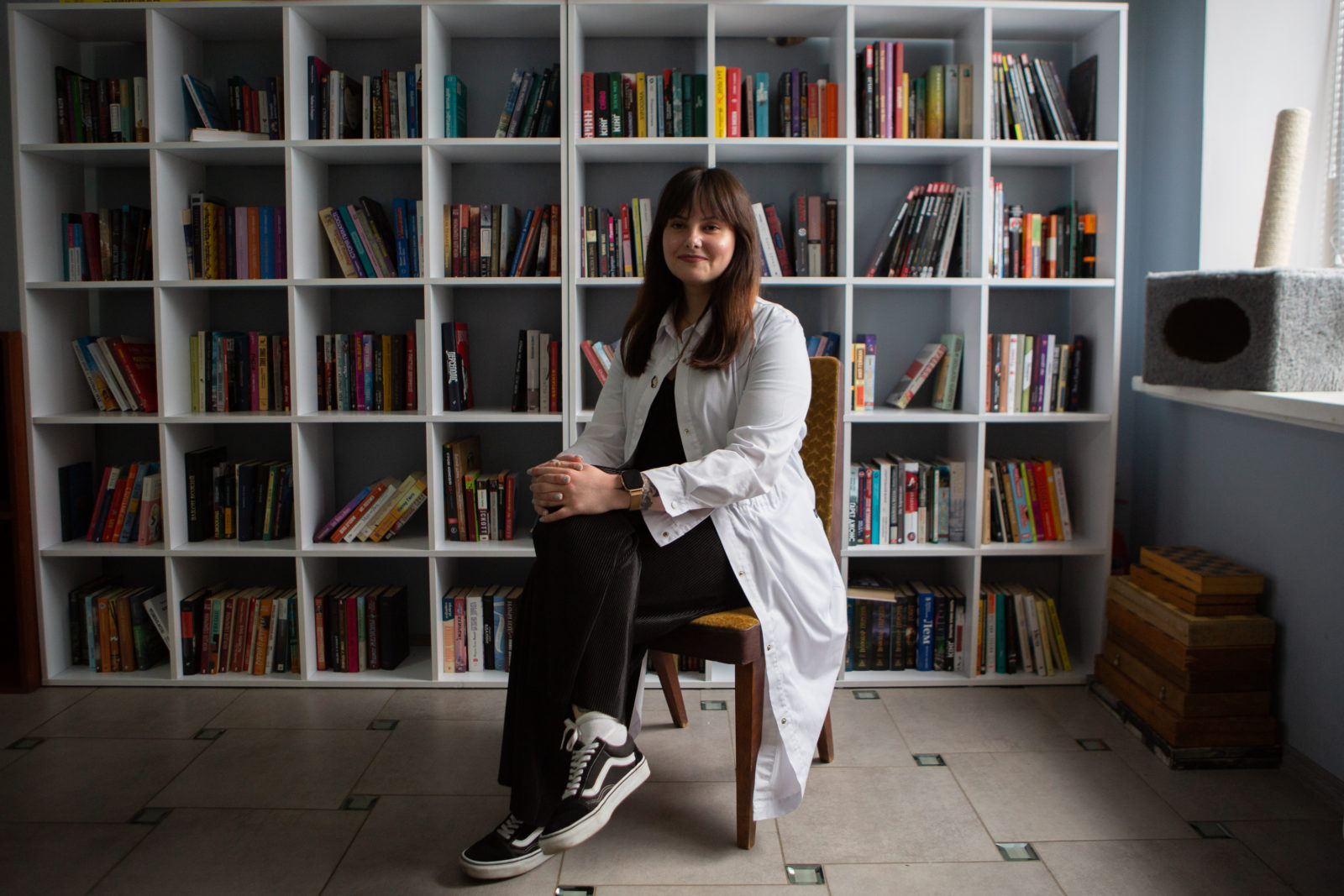
Anastasia works as a psychiatrist. The patients of the department, she says, often show photos and videos from the battles, talk about the harsh conditions, how they can go weeks without eating, drinking, or washing. Photo: Oleksandr Mahula/Suspilne
Those who are deemed unfit by the MMC return home and often don’t know what to do next.
“I had a patient who I’d sometimes find sitting on the floor in the hallway, crying. He was very anxious. He got better, but the MMC declared him unfit. He returned home to his wife and is trying to adjust to civilian life. That’s really the hardest thing, because the guys tell me how they go into a shop or go for a walk and see civilians sitting on benches, drunk, provoking them — and it’s very difficult for them to control themselves. When the war ends and they all come back, we will have to deal with the consequences for a long time.”
“Doesn’t that scare you?“
“Not at all. We do what we can. Whatever has to happen will happen.”
A long way to go
“Sergey, wake up, they’re going to film you now. Good morning,” laughs Sasha, addressing his roommate, who sleeps wrapped in a patterned blanket.
The room is designed to sleep five. Each bed has a bedside table, plants on the windowsills and blinds. Above Sasha’s bed is the flag of his brigade.
“No, no, I’m not photogenic,” mumbles Sergey, getting out of bed lazily. He fumbles for his cigarettes on the windowsill and leaves. Sasha, Viktor and Stas stay in the room. Before the invasion, Stas worked for a chain of hardware stores in Kyiv. He went home on holiday to the Khmelnytskyi region, where he was drafted into the army, sent for training and then sent to the Donetsk region. His brigade is still stationed there.
Sasha, Viktor and Stas are from different battalions, different brigades and had different roles on the battlefield.
Sasha has been in rehabilitation for 10 months.
Viktor is in his ninth month.
Stas is in his third.
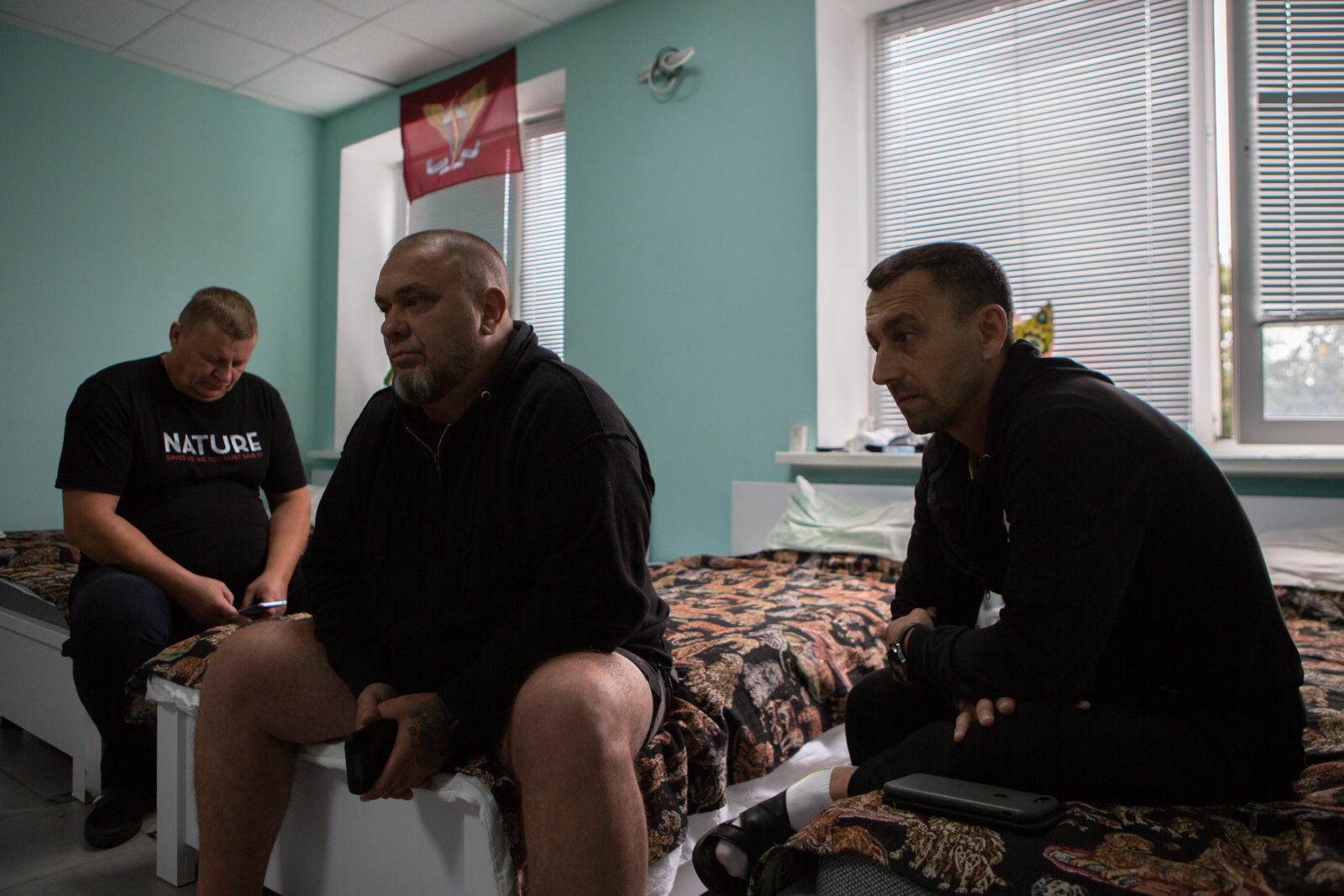
Sasha, Viktor and Stas from different battalions, different brigades, performed different tasks on the battlefield. Now the men share a common ward in the hospital. Photo: Oleksandr Mahula/Suspilne
“How does life here change with time?” I ask them.
“You say it changes?” Stas asks back. “In what way? It doesn’t change at all… My health has improved, I sleep a bit better, I’ve made new friends. But the rest, how can it change? The war is still going on. For life here to change, the whole situation has to change.”
“And until the war is over, the situation will not change,” Stas adds. “There is still a long way to go.”
“The situation does not change, especially when you go to the cemetery. Every day you get a call, and sometimes it’s a ‘cargo 200’ (military code referring to the transportation of military fatalities; translator’s note). It’s always someone from your military training unit, someone from your platoon, your company, your brigade. Some are close comrades, some are distant — but you remember them all.”
“I told you I used to teach at a school,” says Viktor. “Some of my former pupils were also in my platoon. When one of them was wounded, we spent 40 minutes pulling him out of the battlefield. We couldn’t save him. As he was dying, he asked me to tell his son that he loved him very much. His son was in my first year class. When you return to civilian life, the first place you go is not home, but the cemetery.”
“How are you now?” I asked.
“Like any other day.”
“And what kind of a day is it for you today?”
“Today is normal,” Stas smiles. “As you can see, we are talking to you.”
“It’s just hard to even think about going back there,” Sasha says. “You can’t forget it, it’s impossible to forget. But you don’t want to go back.”
“So let’s not think about going back; tell me what your days are like here?” I ask. “Gym, pills, breakfast. And then what?”
“And then we go to the petrol station for coffee,” Viktor answers.
“And then it depends on your schedule,” Sasha continues. “I came here with a different idea of rehabilitation, but it turns out that here you are a free man. Some people watch videos on YouTube, others read, and we walk a lot.”
“You can walk 10 kilometres a day,” Viktor nods.
“You walk, walk, walk. Just to keep on walking.”
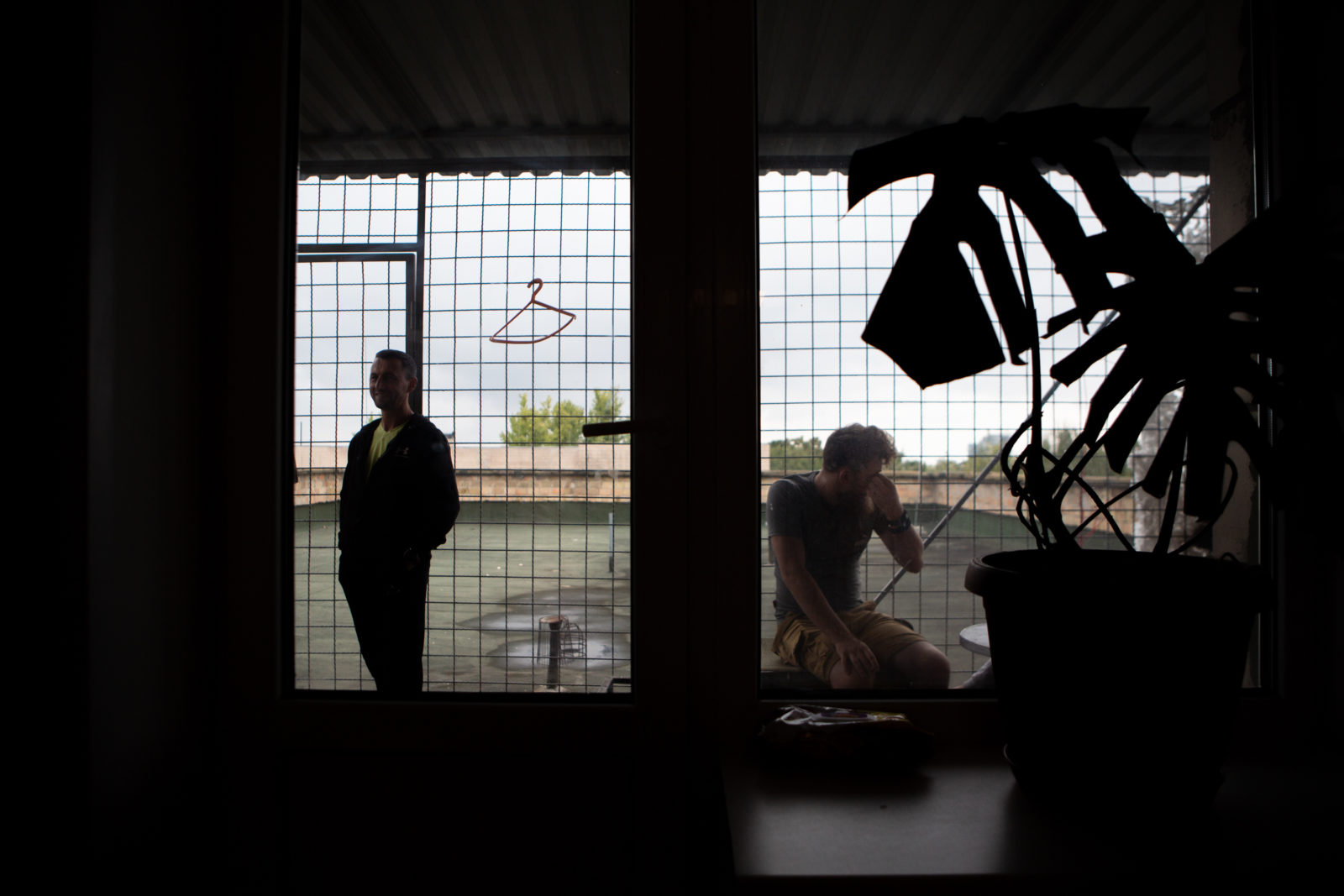
Many soldiers undergoing treatment and rehabilitation say they have seen hell, which is hard to forget, but which they have to learn to live with. Photo: Oleksandr Mahula/Suspilne
Nataša Markovič
Nataša Markovič was selected for the 2024 Shortlist with We Have Betrayed a Generation
Nataša Markovič, Slovenian journalist, editor,co- founder of Preiskovalno (ENG: investigative). She focuses on social exclusion, human rights, elderly and politics. Last 15 years she has been a part of most watched and influential television shows on National television where they uncovered many political corruption stories. As a journalist in the news department she has covered the highest domestic and international bilateral political events. Last year she joined the largest media company Media 24 where in October she established the journalism portal Preiskovalno.si which is dedicated to monitoring the paths of public money, politics, the elderly, and the diseases of the century-cancer.The basic mission of the Preiskovalno media is telling the stories of people without connections, without political pedigree, and people on the margins. The recent story about an abandoned man Andrej who was for four months lying in his own waste resonated in recent months all over the country. Today, thanks to good people and the mayor he has a renovated room and with the help of physiotherapy, he can walk again. After this story was published the municipality found four more abandoned elderly people in the same city.
Markovic holds a master’s degree in science.

